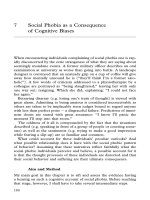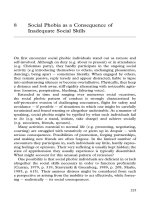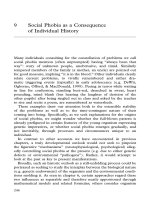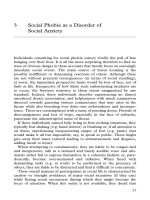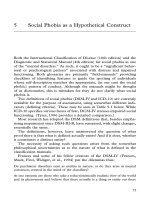Social Phobia as a Disease
Bạn đang xem bản rút gọn của tài liệu. Xem và tải ngay bản đầy đủ của tài liệu tại đây (68.67 KB, 8 trang )
4 Social Phobia as a Disease
We have seen in chapter 3 that social phobia can neither be characterized
as an instance of a ‘‘disordered’’ anxiety nor be considered a disorder of
a singular kind of anxiety. The nature of social phobia then, remains an
open question.
A potential answer might be found in the fact that social phobia is
considered by some physicians a disease. An introduction to a series of
articles published in International Clinical Pharmacology (James, 1997),
for instance, had as title: ‘‘Social phobia À a debilitating disease with a
new treatment option.’’
That much is also implied by the vocabulary in use. Typically,
individuals seeking help are ‘‘diagnosed’’ as ‘‘suffering from’’ social
phobia À ‘‘a debilitating condition with an etiology that has yet to be
established.’’ Fearfulness of and an inclination toward avoidance of
social occasions are said to be its ‘‘symptoms.’’
Moreover, social phobia is at least implicitly recognized as a disease
by international official authorities and by some national pro-
fessional bodies. Its ‘‘diagnosis’’ may be found listed in both the
International Classification of Diseases (ICD-10; Classification of
Mental and Behavioral Disorders) compiled by the World Health
Organization (1992) as well as in the Diagnostic and Statistical
Manual (DSM-IV) published by the American Psychiatric Association
(APA, 1994).
Is social phobia a disease then? Ostensibly, the answer is simple but as
we shall see later, it is bedeviled by complex conceptual issues and the
fact that there is rather little evidence to rely on.
The arguments for considering social phobia a disease are mostly
rhetorical and abstract, rooted in the nature of psychiatric problems in
general. For this reason, I shall take a roundabout route, and before
coming to a conclusion I shall examine the notion of disease and
whether it is applicable to social phobia.
67
Disease or Disorder?
The distinction between disease, illness and sickness is a commonplace
in theoretical medicine. Disease is by definition an organic phenomenon
independent of subjective experience or social conventions. It is mea-
sured objectively; such measurements are the signs of disease. Illness
refers to the subjective complaints communicated by the individual;
these are typically known as symptoms. Sickness is the social phenome-
non; it refers to the individual’s performance of various social roles and
the manner of his/her participation in the life of their community
(see Hofmann, 2002, pp. 652À653).
In the ICD-10 and DSM-IV diagnostic manuals social phobia is
found under the heading of anxiety disorders. What is a disorder? Is it
a synonym of disease?
In its introductory note on terminology, the ICD-10 (World Health
Organization, 1992) explains:
The term ‘‘disorder’’ is used throughout the classification, so as to avoid
even greater problems inherent in the use of terms such as ‘‘disease’’ and
‘‘illness.’’ ‘‘Disorder is not an exact term, but it is used here to imply
the existence of a clinically recognizable set of symptoms or behaviors asso-
ciated in most cases with distress and with interference with personal functions.’’
(p. 5).
A similar line is taken in the DSM-III and subsequent revisions. In the
DSM-IV we find a caveat stating,
although this manual provides a classification of mental disorders, it must
be admitted that no definition adequately specifies precise boundaries for
the concept of mental disorder ... In DSM-IV, each of the mental disorders
is conceptualized as a clinically significant behavioral or psychological
syndrome or pattern exhibited by an individual and that is associated with
present distress (e.g. a painful symptom) or disability (i.e. impairment in
one or more important areas of functioning) or with a significantly
increased risk of suffering death, pain, disability, or an important loss of freedom
(p. xxi).
Significantly, however, it is argued elsewhere (by some of the
individuals who have been in the forefront of the creation of the
DSM-III): ‘‘a mental disorder is a medical disorder whose manifesta-
tions are primarily signs and symptoms of a psychological (behavioral)
nature’’ (Spitzer & Endicott, 1978, p. 18).
While the ICD is reticent in coming to grips with the issue and shies
away from providing a definition of disease or disorder, the DSM
68 What is the Nature of Social Phobia?
appears to have it both ways; it provides no real definition of disease but
insinuates it is dealing with them nevertheless. It explains,
all medical conditions are defined on various levels of abstraction À for example,
structural pathology (e.g. ulcerative colitis), symptom presentation (e.g.
migraine), deviance from a physiological norm (e.g. hypertension), and etiology
(e.g. pneumococcal pneumonia). Mental disorders have also been defined by a
variety of concepts (e.g. distress, dyscontrol, disadvantage, disability, inflexibil-
ity, irrationality, syndromal pattern, etiology, and statistical deviation). Each is a
useful indicator for a mental disorder, but none is equivalent to the concept,
and different situations call for different definitions (p. xxi).
A somewhat less bookish way to shed light on the concepts of disease
and disorder is to look to the use of these terms in medicine. Wiggins &
Schwartz (1994, p. 98) maintain that ‘‘medical doctors rarely speak of
disorders; they refer instead to diseases ... Physicians do employ the
term disorder to express the idea that the patient has a functional
rather than a structural problem.’’ What kind of functioning, however,
do these authors refer to? Is it psychological and behavioral or physio-
logical? The distinction is of utmost importance as the functional
problem in social phobia is maladjustment to life-demands rather than
a bodily one.
As the final step I shall turn to pathology À the authority on disease À
for its applied understanding of the terms disease and disorder.
According to the Robbins Pathologic Basis of Disease, pathology
is ‘‘devoted to the study of the structural and the functional changes
in cells, tissues, and organs that underlie diseases’’ (Cotran, Kumar,
& Robbins, 1994, p. 1). Disease, then, spans the anatomy (structure)
and the physiology (function) of the human organism. In other words
it is ‘‘the structural alterations induced in the cells and organs of the
body (morphologic changes), and the functional consequences of the
morphologic changes’’ (1994, p. 1). By ‘‘functional’’ Cotran et al.
(1994) mean that ‘‘The nature of the morphological changes and their
distribution in different organs or tissues influence normal function
and determine the clinical features (symptoms and signs), course and
prognosis of the disease’’ (p. 1). In other words, in disease functional
abnormalities flow from structural changes; they are not independent
of them.
As functional abnormalities are the consequence of structural ones,
the structural/functional perspectives on disease must not be seen either
as a dichotomy or as mutually exclusive. In some circumscribed
instances, however, one would be able to separate the two perspectives
A Disease 69
as during the period when the structure À say of an organ À is abnormal
while it is still functioning adequately.
In summary, disease is viewed materialistically in terms of (observ-
able) lesions to cells, tissues or organs, identifiable biochemical imbal-
ances, etc. These manifest themselves through signs (e.g. fever),
symptoms (e.g. expressions of suffering) or a combination of the two.
These indicators are used to arrive at a tentative diagnosis. In practice,
some diagnoses may never be validated independently. As a matter of
principle, however, there is a concrete disease independent of its man-
ifest indicators. In the absence of disease the use of the related term of
diagnosis hardly makes sense.
Mental Disorder À a Metaphoric Disease?
For the reasons evoked above, Szasz (1987, pp. 135À169) considers the
use of the term ‘‘mental illness’’ or its modern equivalent À disorder À
misleading and a fallacy. In his view the use of the term ‘‘disease’’ ought
to be limited to material disease only. The definition of disease by
distress and maladjustment is, according to him, a metaphoric one,
arrived at by analogy.
The reasoning is as follows: since individuals with a bodily
(i.e. material) disease suffer and may have trouble leading well-adjusted
lives, those who resemble them may be deemed to be diseased as well.
As one might look at disease functionally (in terms of physiology e.g.
when no lesions are observed) poor psychological functioning by an
inversed logic could also be conceived along the lines of a disease
(disorder). According to Szasz (1987) if such patients may be said to
be sick at all, it is figuratively (in terms of metaphor), as when saying
‘‘sick with love’’ to describe someone driven to distraction or ‘‘it makes
me sick’’ to express disgust and disapproval.
In a similar vein, Lenin, whose chief preoccupation after seizing power
in October 1917 was to hold on to it, diagnosed (some) of his more
upright comrades’ scruples about abandoning principle for expediency,
as symptoms of left-wing communism À an infantile disease.
Social Phobia À a Neurological Disease?
Recent decades have been characterized by an intensification of a
biologizing trend in the search for explanations of abnormality, espe-
cially in US psychiatry. Consequently, some authors have come to
denounce and reject the distinction made between the two kinds of
disease À mental and otherwise (described above) À striving to show
70 What is the Nature of Social Phobia?
that mental disorder (defined psychologically) is medical (i.e. material
disease) after all. This quest À despite its modern ring À has actually
a long pedigree as suggested by Griesinger’s (1845) maxim:
‘‘Geisteskrankheitn sind Gehirnkrankheitn’’ (mental diseases are diseases
of the brain, quoted in Mooij, 1995).
As a working hypothesis, such a possibility is eminently plausible À
either for social phobia or for any other problem. Andreasen (1984,
p. 29), for example asserts, ‘‘The major psychiatric illnesses are diseases.
They should be considered medical illnesses just as diabetes, heart
disease and cancer are.’’ On what grounds? Because
The various forms of mental illness are due to many different types of brain
abnormalities, including the loss of nerve cells and excesses and deficits in chem-
ical transmissions between neurons; sometimes the fault may be in the pattern of
the wiring or circuitry, sometimes in the command centers and sometimes in the
way messages move along the wires 1984, (p. 221).
To sum it up, ‘‘Mental illnesses are diseases that affect the brain,
which is an organ of the body just as the heart or the stomach is.
People who suffer from mental illness suffer from a sick or broken brain.’’
What evidence is there to bolster such claims? Concerning anxiety
disorders as a group (social phobia is not discussed on its own), the
author first expresses the hope that ‘‘anxiolytic’’ medication might
shed light on the neurochemistry of anxiety. As to actual evidence, we
are told that there is a possibility of a genetic component to anxiousness,
that panic may be induced in certain patients with the infusion of lactate
and that there is a link between panic and mitral-valve prolapse (see
Andreasen, 1984, pp. 239À243). These hardly give support to the
rather sweeping assertions of ‘‘brain abnormalities.’’
Sheehan (1986) advocates a broadly similar approach. Although in his
book The anxiety disease social phobia is broached tangentially À as a
stage in the development of what he terms the anxiety disease À his
views have a bearing on our topic.
‘‘The proposed model suggests that at the center of this disease, feed-
ing it like a spring, is a biological and probably a biochemical disorder’’
(p. 90). Secondary (exacerbatory) roles are accorded however to
psychological (i.e. conditioning) processes and environmental stresses.
In support of his construal, the author asserts that there is evidence
that vulnerability to the disease may be genetically inherited, and that
it is
possible that such a genetic weakness could give rise to biochemical abnormal-
ities ... What are the precise biochemical abnormalities in this disease? No one
yet knows with certainty ...The best guesses so far involve certain nerve endings
A Disease 71




